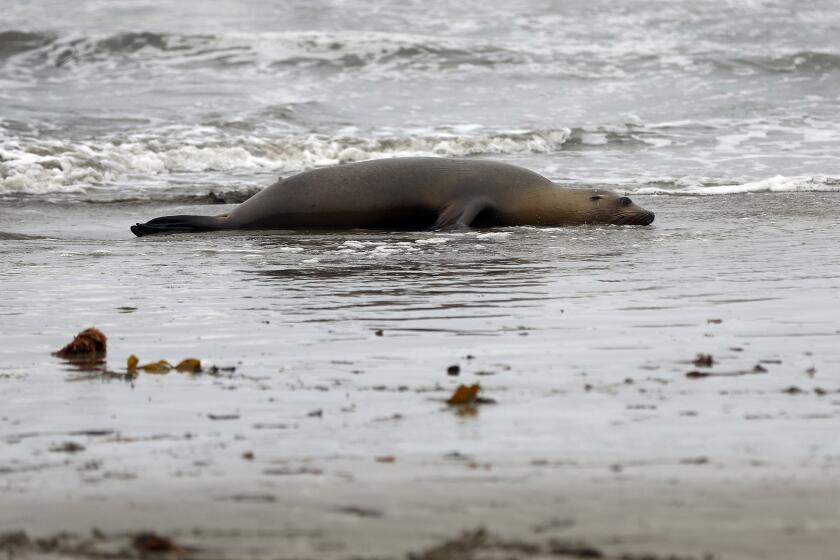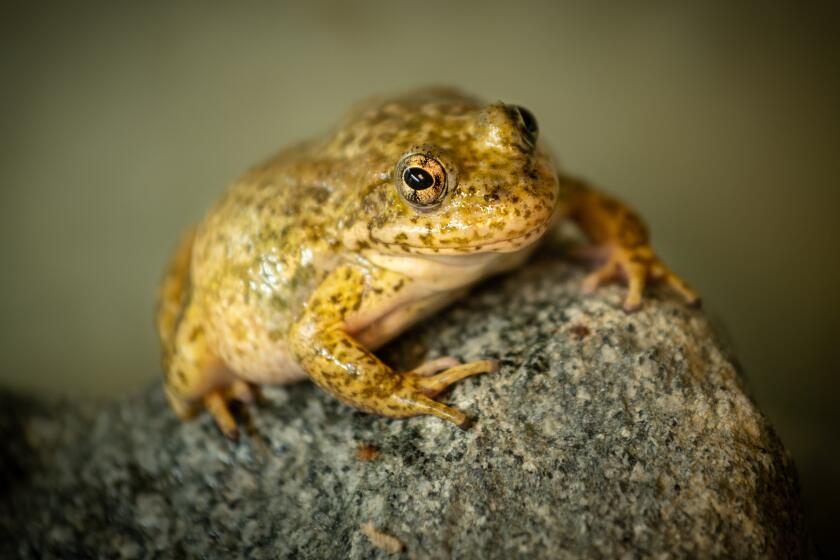
- Share via
- A 2023 California Department of Fish and Wildlife report found that roughly 88% of raptors and 90% of pumas tested were exposed to the poisons.
- The law allows the poisons to be used in agricultural settings and public health emergencies.
California has become the first state in the nation to restrict use of all blood-thinning rat poisons due to their unintended effect on mountain lions, birds of prey and other animals.
Gov. Gavin Newsom recently signed a bill that expands an existing moratorium to all anticoagulant rodenticides, with only limited exceptions. The poisons prevent an animal’s blood from clotting and cause it to die from internal bleeding. When an unsuspecting mountain lion or owl gobbles a dead or sick rat — or another animal that ate a tainted rat — the toxic substance can be passed on.
Wildlife advocates hailed the new law — set to go into effect Jan. 1 — as an important step toward protecting non-target animals. However, agricultural and pest-control groups derided the measure as a potential public health issue that sidestepped the state’s regulatory process.
Gov. Gavin Newsom signs a bipartisan bill banning octopus farming in the state. California is now the second state to do so.
“I’m so proud that California is leading the way in protecting wildlife from these harmful and unnecessary poisons,” said J.P. Rose, urban wildlands policy director at the Center for Biological Diversity, which sponsored AB 2552. “I think we can all agree that unintentionally poisoning native wildlife is wrong.”
A 2023 California Department of Fish and Wildlife report found that roughly 88% of raptors and 90% of pumas tested had been exposed to the poisons. Birds of prey — and American kestrels in particular — have been significantly harmed by chlorophacinone, one of two poisons targeted in the law, according to Lisa Owens Viani, director of Raptors Are the Solution, a co-sponsor of the bill.
Megan J. Provost, president of Responsible Industry for a Sound Environment, a trade association for the specialty pesticide and fertilizer industry, which opposed the bill, pointed to its potential harm to humans.
“Effective rodenticide products are necessary for protecting the health and safety of people, structures and businesses — including those responsible for food safety — from the diseases and property damage caused by rats and other harmful rodents,” Provost said in a statement. The new law “unfortunately removes products from the pest control toolbox that are important for managing rodent infestations, leaving fewer products for effective immediate and long-term control and for managing resistance in rodents.”
She said California’s Department of Pesticide Regulation has wide latitude to evaluate pesticides for safety “so pesticide-specific legislation … that supersedes this process was unnecessary.”
The law allows the poisons to be used in agricultural settings and public health emergencies.
Owens Viani said legislation and other efforts were necessary because state pesticide regulators were unwilling to act on their own.
“We’re ahead of the rest of the country with these regulations, but it hasn’t been because DPR has been a willing partner,” Owens Viani said. “We’ve had to force them every step of the way.”
A spokesperson for the agency said it “has been actively evaluating risks” related to the rodenticides since 2014.
“Evaluation has included both monitoring for impacts through a partnership with the California Department of Fish and Wildlife and initiating formal reevaluation to inform future actions to mitigate risks to wildlife,” the spokesperson said in a statement.
Owens Viani said her organization has worked for about a decade on passing legislation, including two previous laws that banned other blood-thinning rat poisons. A suit her nonprofit filed against the state agency is ongoing.
Unprecedented deaths of sea lions along California’s Central Coast
The early seeds of Owens Viani’s work on the issue began around 2011, when a neighbor ran over to tell her that Cooper’s hawk fledglings had drowned in his kiddie pool. At the time, she was studying raptors at the Golden Gate Raptor Observatory and had a hunch rat poison was involved. Tests confirmed it.
“It kept happening in my neighborhood, like people kept finding more dead hawks,” she said. They weren’t eating the bait; they were eating rats. “I knew that if people were using poison in my eco-friendly neighborhood in Berkeley, it was probably a problem everywhere. And so that’s when I decided to found my nonprofit and try to educate more people about the problem.”
The latest legislation, authored by Assemblymember Laura Friedman (D-Glendale), tightly restricts the use of chlorophacinone and warfarin, which are known as first-generation anticoagulant rodenticides. A law signed in 2020 put a moratorium on second-generation anticoagulant rodenticides. And last year the only other first-generation poison was added through a separate law.
The older first-generation version is slower-acting, requiring the rat to feed on the poison several times before it dies. The second-generation version is more potent, earning the moniker “one-feeding kills.”
Other states are working on similar efforts, but Owens Viani said only California has enacted a moratorium. British Columbia has placed a permanent moratorium on second-generation poisons, and the U.S. Environmental Protection Agency removed those types of poison from consumer shelves, she said.
The ban will remain in place until the state Department of Pesticide Regulation reevaluates the poisons and comes up with restrictions that meet certain criteria to protect wildlife.
The law also creates civil penalties. Anyone who sells or uses the poisons in violation of the law is subject to a fine of up to $25,000 per day for each violation.
Any money collected from violations will go to the Department of Pesticide Regulation to cover its costs in administering and enforcing the rules, and potentially other activities.
The department estimated the law would create a one-time cost of $258,000 and an ongoing annual cost of $193,000 to support a position “to handle anticipated increases in follow-ups and complaints associated with investigating sales and restricted materials,” according to a government analysis of the bill.
Fires could encroach on critical habitat for the endangered Southern California mountain yellow legged frog.
The analysis anticipates revenue loss of an unknown amount to the department, as well as to the California Department of Food and Agriculture’s Vertebrate Pest Control Research Advisory Committee.
The agency said it is committed to “a timely completion of its reevaluations.” Another bill signed into law this year requires that the agency share a timeline and status of all reevaluation and mitigation by the end of the year.
“The reevaluations underway include an assessment of cumulative impacts of anticoagulant rodenticides,” including first-generation varieties, the agency said in a statement, adding that it “will continue its ongoing work to address unintended wildlife exposure from first-generation and second-generation rodenticides while still retaining tools to protect public health, agriculture, critical infrastructure and the environment.”
Wildlife advocates said they compromised on certain elements of the bill as it wound through the Legislature and encountered opposition.
For example, a previous version of the bill allowed members of the public to sue bad actors for breaching the law.
An L.A. Times editorial from earlier this year pitched this as a powerful element of the legislation, which “could help curb the use of banned rodenticides by empowering all Californians to become enforcers.”
However, the California Chamber of Commerce called it “an expansive new private right of action that threatened businesses and created incentives for frivolous lawsuits,” and removed its opposition once the provision went away.
Owens Viani said proponents had also hoped to create buffer zones around agricultural areas, where birds of prey forage and which are part of habitat ranges for mountain lions, coyotes and other animals.
But there were other wins. Rose pointed out what he described as “exciting language … around the sentience of animals.”
The law text notes that animals “are able to subjectively feel and perceive the world around them” and that the “Legislature has an interest in ensuring that human activities are conducted in a manner that minimizes pain, stress, fear and suffering for animals and reflects their intrinsic value.”
Toward a more sustainable California
Get Boiling Point, our newsletter exploring climate change, energy and the environment, and become part of the conversation — and the solution.
You may occasionally receive promotional content from the Los Angeles Times.










